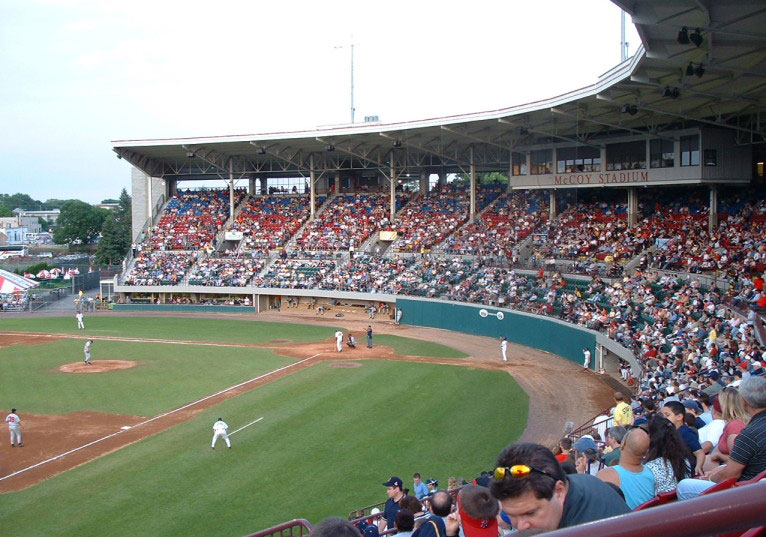The murals that adorn the concourse at McCoy Stadium, home of the Pawtucket Red Sox (Class AAA; International League), tell a rich history of professional baseball in New England.
There’s a cascade of images of Boston Red Sox greats from the more than 40 years that McCoy has been the home of the Red Sox’s Triple-A franchise. As fans make their way up the walkway toward their seats, the likes of Jim Rice, Fred Lynn, Wade Boggs and Nomar Garciaparra, among others, look back at them, forever immortalized in vivid color.
In another part of the concourse, a vast painted display tells the tale of McCoy’s most famous game, the 33-inning epic in 1981 that still stands as professional baseball’s longest game.
But it is the stadium itself that stands as living history. Although the Red Sox have been its occupant since the early 1970s, McCoy has stood now for 75 years this summer, the oldest ballpark in the International League.
A New England institution that finds itself struggling to stay alive amid dwindling attendance and attempts by ownership to build a new facility, McCoy Stadium, whatever its future, will always possess a rich history to celebrate.
The groundbreaking for McCoy Stadium took place in the early 1940 and the ballpark was completed in 1942, even though it was not named for Pawtucket mayor Thomas McCoy until 1946. That was the first year the stadium hosted a minor league franchise, the Pawtucket Slaters, a Class B affiliate of the Boston Braves.
The Braves left Pawtucket after the 1949 season and the city did not host a professional team again until 1966, when the Double-A affiliate of the Cleveland Indians called McCoy home for two years before moving to Waterbury, CT.
It was not until 1970 that the marriage between McCoy Stadium and the Red Sox was first forged. For three seasons, the Pawtucket Red Sox were a Double-A franchise. They became the Triple-A affiliate in 1973, and won the International League championship in that first season, led by future Red Sox stars such as Rick Burleson, Cecil Cooper, Juan Beniquez and Dick Pole.
Jim Rice and Fred Lynn would arrive in 1974 and a legacy was forged. Located just two hours from Boston, Pawtucket became a highly-convenient location for the team, allowing the Red Sox to make critical call-ups virtually on game day, as long as players were able to successfully navigate the oft-congested I-95 North corridor.
But for all the on-field success and budding talent the PawSox were able to cobble together in the mid-1970s, the team struggled financially and two separate owners threatened to move the franchise (one to New Jersey, the other to Massachusetts) before Ben Mondor purchased the club in 1977 and forever changed the fortunes of the franchise.
Under Mondor’s leadership, McCoy underwent a major renovation in 1999, increasing seating capacity from its original 6,000 to over 10,000. Among the improvements was the addition of a berm in left-field, that allowed fans a close-up view, as well as luxury boxes.
The first season after the renovations, in 1999, the PawSox averaged 8,286 – the team barely averaged more than 1,000 in Mondor’s first year owning the team in. Their attendance figures peaked in 2005, the year after the Boston Red Sox won their first World Series title in 86 years, with 688,421.
The single-game record was set in 2009, with 11,982 attending a game on April 17.
And those fans who passed through the turnstiles those years were treated to some of the most historic moments ever seen in Triple-A baseball. None more memorable than what began on the night of April 18, 1981 and ended on June 23 that same year.
In what still stands as the longest game in professional baseball history, Pawtucket and the Rochester Red Wings played to a draw before the PawSox finally prevailed 3-2 in 33 innings.
The first 32 innings were played that April night, as the game — which featured Wade Boggs for the PawSox and Cal Ripken Jr. for the Baltimore Orioles’ affiliate – stood at 1-1 after 20 innings and continued on into the morning hours after each team scored a run in the 21st inning. The game was not suspended until 4:07 a.m., after 32 innings, with just 19 fans remaining in the stands. All 19 would receive lifetime passes to PawSox games, including the resumption of the April 18 game on June 23.
The Longest Game needed only 18 minutes upon restart, as Dave Koza delivered a walk-off hit in the bottom of the 33rd inning for a 3-2 PawSox win.
Perhaps the other most famous moment in McCoy history was a dubious achievement by Red Sox minor leaguer Izzy Alcantara, who made the blooper reels for immortality by starting a fight in 2001 by karate-kicking the opposing catcher to the ground before charging the mound to start a fight.
Among the other players who called McCoy their home park before graduating to Fenway Park were Roger Clemens, Mo Vaughn, Dustin Pedroia and Jon Lester. Curt Schilling (2005, 2007) and David Ortiz (2008, 2013) made rehab appearances at McCoy, while Clemens and Garciaparra played games at McCoy both before and during their Boston Red Sox careers.
But for all their success – the PawSox would add three more International League titles in 1984, 2012 and 2014 – the team began struggling at the gate after Mondor’s death in 2010. And while the plan to move the team to a new ballpark in Providence failed, McCoy’s lease is due to expire in 2020, and there are no guarantees the team will remain in Pawtucket, or even Rhode Island, perhaps leaving Pawtucket with nothing more than painted images of a glorious past.
This article first appeared in the weekly Ballpark Digest newsletter. Are you a subscriber? It’s free, and you’ll see features like this before they appear on the Web. Go here to subscribe to the Ballpark Digest newsletter.


